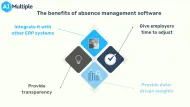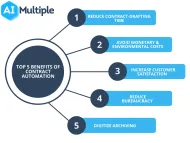5 Ways RPA Enables Accurate & Insightful Compliance in 2024
Compliance efforts are necessary practices to ensure that a business is keeping up with internal and external regulations and policies, which helps businesses detect violations and fraud, and avoid fines and lawsuits. However, according to Deloitte, accomplishing effective compliance is a challenging process due to cost, quality, and consistency of monitoring and assurance, as well as difficulty of coordination between different business departments.
In this article, we explore the challenges in compliance, how automation can tackle them, and recommendations to ensure accurate and insightful compliance functions.
1. Eliminate unauthorized access to privileged data
Different industries leverage customers’ personal data or third-party data (e.g. IoT data) to make data-driven decisions. Any error in processing and storing such data may compromise privileged data and expose it to non-authorized individuals, thus, violating data privacy regulations and policies. And under the EU GDPR, authorities can fine organizations that violate data privacy regulations up to 4% of their worldwide turnover for the preceding financial year.
Recommendation
RPA bots can replicate data manipulation processes such as entry, transfer, and storage, without human intervention. Leveraging bots to automate data processes will:
- Reduce the chance of data errors
- Eliminate unauthorized access to privileged data
- Create an audit trail to review and monitor user activity
2. Verify process logs against regulations and policies
According to Deloitte, 17% of businesses do not conduct regular risk assessment to identify compliance risks, exposing the organization to reputational risks. The report reveals that lack of risk assessment is due to the leaders’ initial focus being on developing compliance capabilities.
Recommendation
Deploy RPA for monitoring and assessment of compliance-related tasks. Bots can verify process logs against regulation and policy documents to detect missing steps and non-compliant processes, and notify auditors of recurring non-compliant processes.
3. Automate low value regulatory reporting tasks
According to Deloitte, only 24% of the time is spent on analyzing reports and making data-driven decisions, The remaining 76% of the report delivery time is spent on low value adding tasks, such as generating the reports according to templates and ensuring quality data.
Recommendation
Leverage RPA bots for generating regulatory reports from business data in designated time of the month or year. RPA bots can be programmed to extract data from business datasets, verify that the data matches original sources (e.g. finance reports, invoices, CRM data), and generate compliance reports and send them to relevant employees for verification. Additionally, bots can identify mismatches in data and notify users of data errors and duplicates to ensure better risk assessment.
4. Keep up to date with regulatory requirements
In a KPMG survey, 60% of organization leaders reported that they do not use automation for regulatory requirements and laws (e.g. Dodd-Frank Act, HIPAA, FISMA) which are frequently modified by policy makers. Updating internal policies to reflect external policy modifications is a repetitive and time consuming task.
Recommendation
Rely on RPA bots to scrape policy makers’ websites, extract news about regulations, laws, or rules, and update regulation data in the organization’s internal regulation databases. Bots can also send emails to notify relevant employees about novel or modified regulations so they can update their policies accordingly.
5. Minimize errors in onboarding and due diligence
Third-party onboarding and due diligence is done when an organization wants to outsource specific tasks to third parties, which may include access to privileged data. This is a repetitive time consuming process (15,000 hours a year) of third-party data entry, verification against existing legal records and documents, and risk score calculation and assignment. However, failure to assess the profiles and risks of third parties can have significant impact on business data; 74% of organizations that faced data breaches said it was a result of providing too much privileged access to third parties.
Recommendation
Leverage bots to complete due diligence processes to reduce human errors, increase speed of onboarding completion, and generate a comprehensive audit trail for later compliance analysis. Bots can also be programmed to route third parties to employees if they came out with a risk score higher than a selected threshold.
For more on compliance technology
To explore different technologies that your business can leverage for compliance automation, read our in-depth articles:
- AI Audit: Guide to faster & more accurate audits
- Anti Money Laundering Algorithms: Tackling AML with AI
- KYC Automation: 5 Technologies for Better Transparency
For a detailed overview of how RPA works and how it can help you transform your business, download our comprehensive whitepaper on the topic:
If you want to leverage RPA and other automation solutions in your business digital transformation, check our data-driven lists of:
And let us help you choose the right tool for your business:
This article was drafted by former AIMultiple industry analyst Alamira Jouman Hajjar.

Cem has been the principal analyst at AIMultiple since 2017. AIMultiple informs hundreds of thousands of businesses (as per similarWeb) including 60% of Fortune 500 every month.
Cem's work has been cited by leading global publications including Business Insider, Forbes, Washington Post, global firms like Deloitte, HPE, NGOs like World Economic Forum and supranational organizations like European Commission. You can see more reputable companies and media that referenced AIMultiple.
Throughout his career, Cem served as a tech consultant, tech buyer and tech entrepreneur. He advised businesses on their enterprise software, automation, cloud, AI / ML and other technology related decisions at McKinsey & Company and Altman Solon for more than a decade. He also published a McKinsey report on digitalization.
He led technology strategy and procurement of a telco while reporting to the CEO. He has also led commercial growth of deep tech company Hypatos that reached a 7 digit annual recurring revenue and a 9 digit valuation from 0 within 2 years. Cem's work in Hypatos was covered by leading technology publications like TechCrunch and Business Insider.
Cem regularly speaks at international technology conferences. He graduated from Bogazici University as a computer engineer and holds an MBA from Columbia Business School.
To stay up-to-date on B2B tech & accelerate your enterprise:
Follow on

Comments
Your email address will not be published. All fields are required.